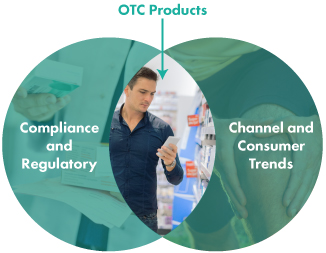The Reasons to Review Your Consumer Health & OTC New Product Launch Processes
On average, a $3 billion consumer healthcare company spends between $60 million to $90 million dollars each year on research and development (R&D) for new product innovation. But, the fully-loaded cost for new product launch can actually be 5-7 times greater than the R&D expenses when you consider integrated marketing campaigns, trade spend, and other commercialization investments.
Anticipated Category Growth
According to the Consumer Healthcare Products Association (CHPA) the largest growth categories for over-the-counter (OTC) manufacturers include respiratory (+10%), hair growth (+7.4%), external analgesics (+6.8%), and feminine needs (+6.6%). With respiratory OTC sales at $7.7 billion last year – that means more than $770 million dollars in additional sales are expected in the respiratory category – many of which will come from new products.
Complexities at Play
Although the opportunity is tremendous, consumer healthcare companies often miss opportunities to move to market quickly resulting in costly, ineffective launches with new produ cts that fail to achieve their full potential. Challenging compliance and regulatory factors from the pharmaceutical industry and constantly changing channel and consumer trends of the consumer products industry intersect in a unique way for OTC products. Speed is almost always seen as a trade-off for quality in OTC products, but this does not need to be the case.
cts that fail to achieve their full potential. Challenging compliance and regulatory factors from the pharmaceutical industry and constantly changing channel and consumer trends of the consumer products industry intersect in a unique way for OTC products. Speed is almost always seen as a trade-off for quality in OTC products, but this does not need to be the case.
Even though getting product launched for OTC can be more challenging than other consumer products, the outcomes consumers expect are the same. Therefore, it is critical for companies to consider the impacts of a fast-paced industry on new product commercialization processes developed more than three or four years ago. As the industry changes quickly around most OTC companies, temporary process fixes are being put in place – leaving a lot of room for optimization around the new product commercialization process.
Reasons to Review your New Product Launch Process
By implementing continuous improvement principals in the commercial launch processes and capabilities, companies will be able to realize efficiency gains, maximize launches, improve alignment and allocation of resources. Companies will not only launch new products faster but they can realize gains of more than 15% over a five-year period.
It can be an uphill battle to convince leadership that a change is required in the new product commercialization process, particularly in a category that is growing. There is always some risk associated with re-tooling a process that some think is working – even if it isn’t fully optimized. However, new product launches rely so heavily on cross-functional collaboration and effectiveness and how well different departments work together can depend as much on the new product commercialization process in place as on the people that are performing the roles.
If your consumer healthcare company has not done a comprehensive evaluation of your new product commercialization process in the last three years, your process is under-performing. It’s time to look at the changing drivers of your industry to capture financial improvements that are waiting for you to take action. At a minimum, you would likely see a product launch cycle time reduction of more than 10% and improvements in new product profit margin of 3%.
Subscribe to Clarkston's Insights
Contributions from Megan Weldon


